Case Study Analysis: Business Development Strategies and Challenges
VerifiedAdded on 2023/01/03
|12
|3570
|76
Case Study
AI Summary
This document presents a comprehensive analysis of several case studies relevant to business development. The first case study examines the inadequate utilization of digital transformation benefits, highlighting the lack of digital expertise among executives and the importance of integrating digital strategies into organizational planning. The second case study focuses on Domino's Pizza, showcasing their innovative product development and marketing strategies. The third case study delves into organizational change, exploring challenges in implementing reforms and strategies for successful adaptation. The final case study discusses creativity in organizations, emphasizing the role of management support and employee involvement in fostering innovation. The document provides valuable insights into various aspects of business development, including strategic planning, digital transformation, and organizational change management.

Case Study 1-5
Paraphrase This Document
Need a fresh take? Get an instant paraphrase of this document with our AI Paraphraser
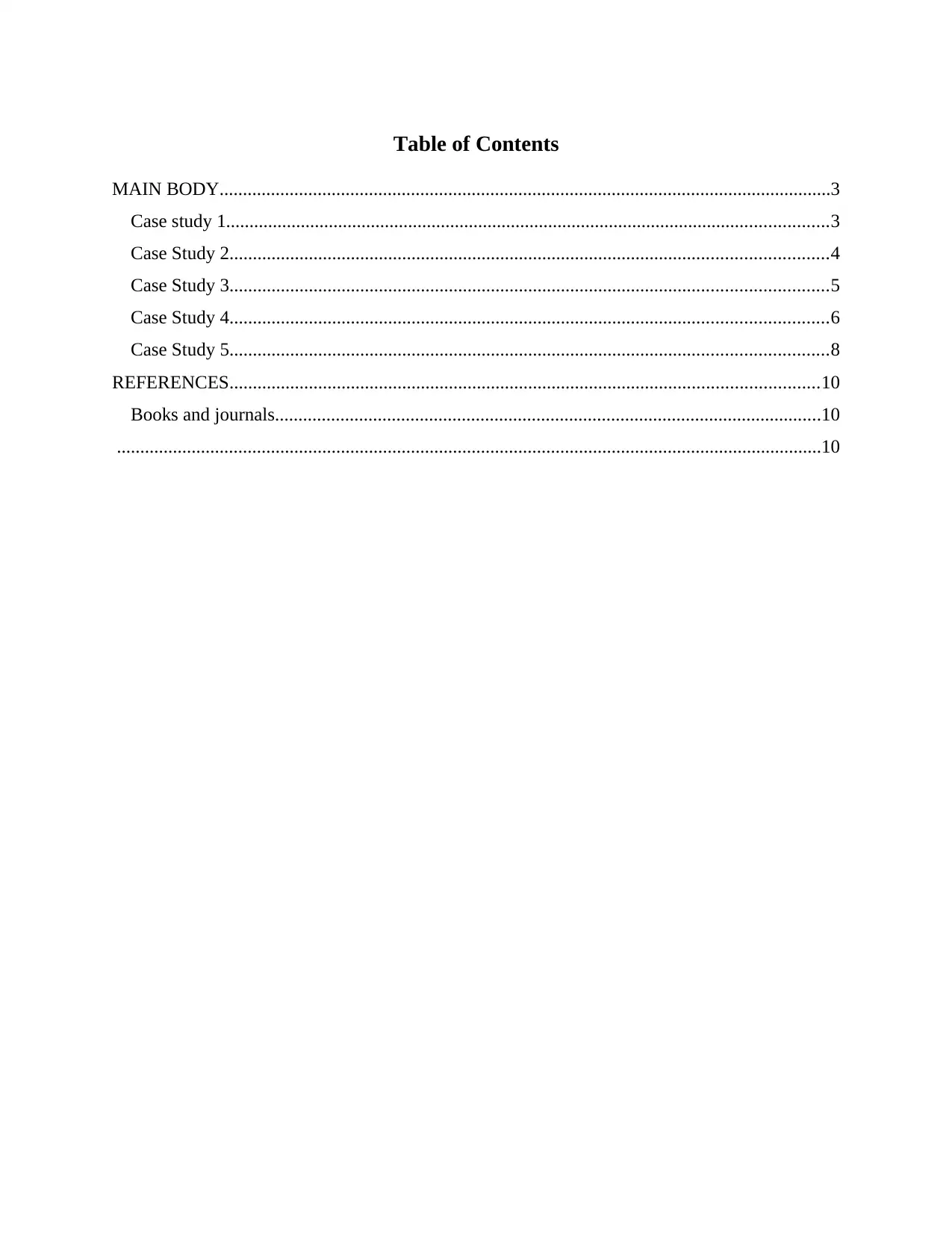
Table of Contents
MAIN BODY...................................................................................................................................3
Case study 1.................................................................................................................................3
Case Study 2................................................................................................................................4
Case Study 3................................................................................................................................5
Case Study 4................................................................................................................................6
Case Study 5................................................................................................................................8
REFERENCES..............................................................................................................................10
Books and journals.....................................................................................................................10
.......................................................................................................................................................10
MAIN BODY...................................................................................................................................3
Case study 1.................................................................................................................................3
Case Study 2................................................................................................................................4
Case Study 3................................................................................................................................5
Case Study 4................................................................................................................................6
Case Study 5................................................................................................................................8
REFERENCES..............................................................................................................................10
Books and journals.....................................................................................................................10
.......................................................................................................................................................10
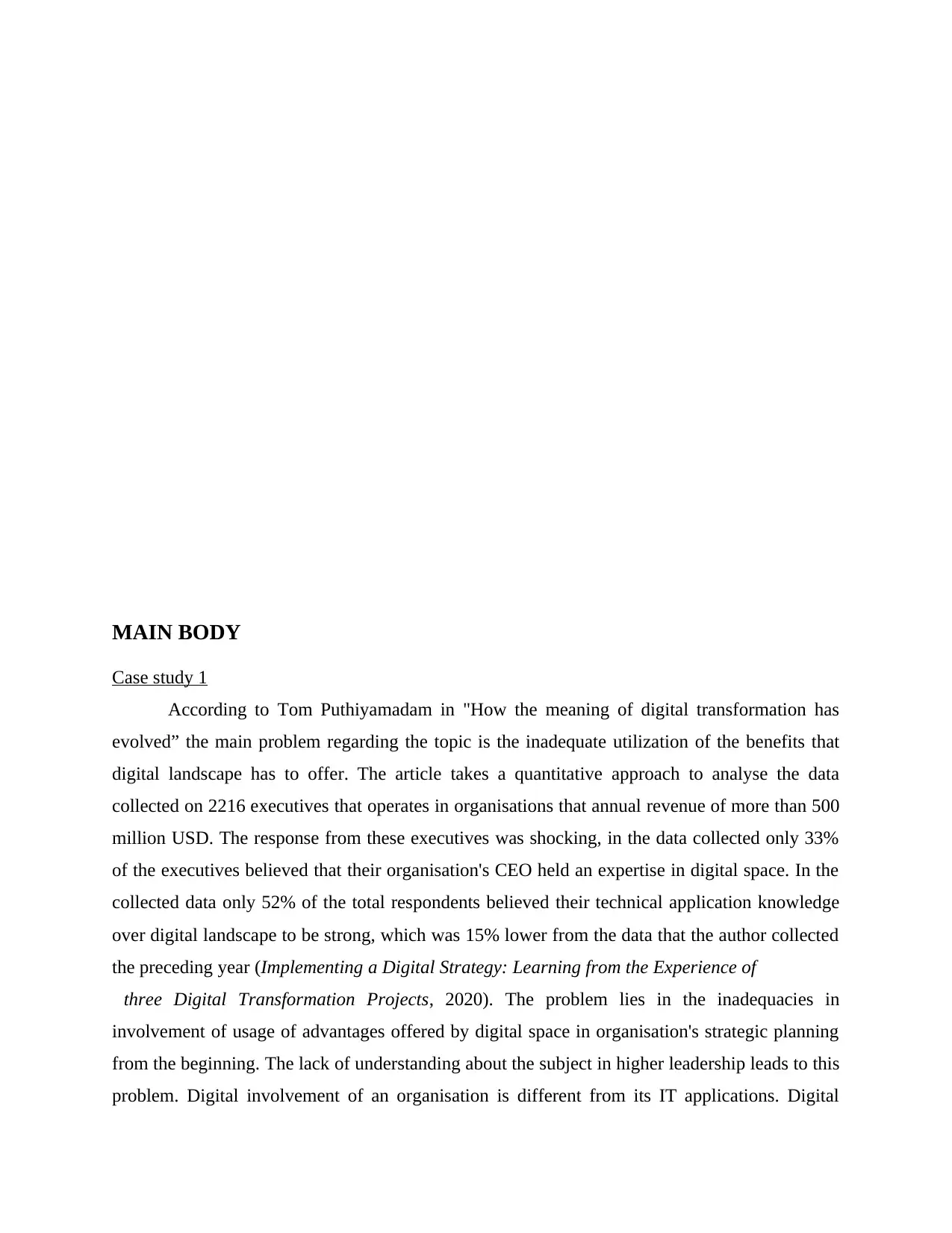
MAIN BODY
Case study 1
According to Tom Puthiyamadam in "How the meaning of digital transformation has
evolved” the main problem regarding the topic is the inadequate utilization of the benefits that
digital landscape has to offer. The article takes a quantitative approach to analyse the data
collected on 2216 executives that operates in organisations that annual revenue of more than 500
million USD. The response from these executives was shocking, in the data collected only 33%
of the executives believed that their organisation's CEO held an expertise in digital space. In the
collected data only 52% of the total respondents believed their technical application knowledge
over digital landscape to be strong, which was 15% lower from the data that the author collected
the preceding year (Implementing a Digital Strategy: Learning from the Experience of
three Digital Transformation Projects, 2020). The problem lies in the inadequacies in
involvement of usage of advantages offered by digital space in organisation's strategic planning
from the beginning. The lack of understanding about the subject in higher leadership leads to this
problem. Digital involvement of an organisation is different from its IT applications. Digital
Case study 1
According to Tom Puthiyamadam in "How the meaning of digital transformation has
evolved” the main problem regarding the topic is the inadequate utilization of the benefits that
digital landscape has to offer. The article takes a quantitative approach to analyse the data
collected on 2216 executives that operates in organisations that annual revenue of more than 500
million USD. The response from these executives was shocking, in the data collected only 33%
of the executives believed that their organisation's CEO held an expertise in digital space. In the
collected data only 52% of the total respondents believed their technical application knowledge
over digital landscape to be strong, which was 15% lower from the data that the author collected
the preceding year (Implementing a Digital Strategy: Learning from the Experience of
three Digital Transformation Projects, 2020). The problem lies in the inadequacies in
involvement of usage of advantages offered by digital space in organisation's strategic planning
from the beginning. The lack of understanding about the subject in higher leadership leads to this
problem. Digital involvement of an organisation is different from its IT applications. Digital
⊘ This is a preview!⊘
Do you want full access?
Subscribe today to unlock all pages.

Trusted by 1+ million students worldwide
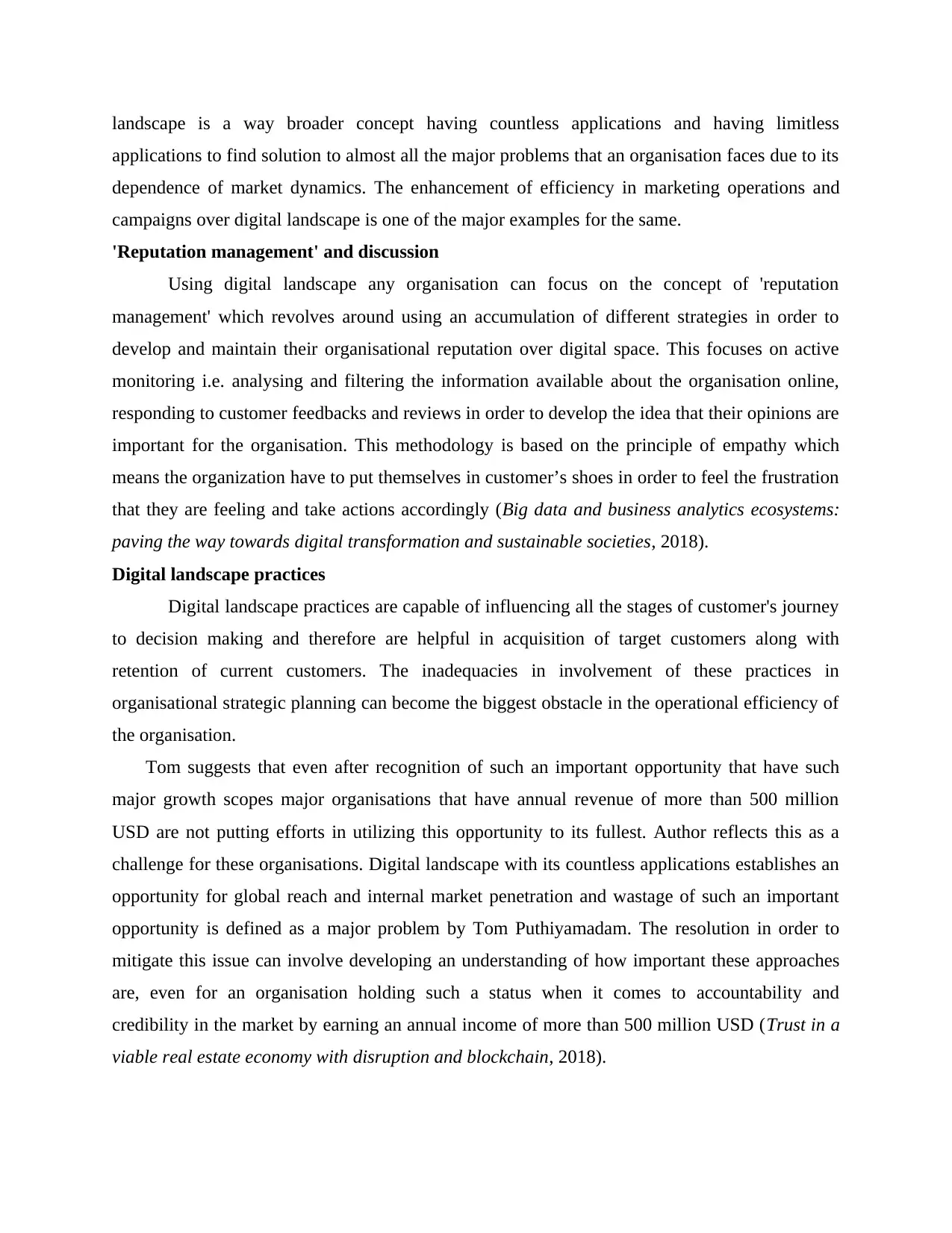
landscape is a way broader concept having countless applications and having limitless
applications to find solution to almost all the major problems that an organisation faces due to its
dependence of market dynamics. The enhancement of efficiency in marketing operations and
campaigns over digital landscape is one of the major examples for the same.
'Reputation management' and discussion
Using digital landscape any organisation can focus on the concept of 'reputation
management' which revolves around using an accumulation of different strategies in order to
develop and maintain their organisational reputation over digital space. This focuses on active
monitoring i.e. analysing and filtering the information available about the organisation online,
responding to customer feedbacks and reviews in order to develop the idea that their opinions are
important for the organisation. This methodology is based on the principle of empathy which
means the organization have to put themselves in customer’s shoes in order to feel the frustration
that they are feeling and take actions accordingly (Big data and business analytics ecosystems:
paving the way towards digital transformation and sustainable societies, 2018).
Digital landscape practices
Digital landscape practices are capable of influencing all the stages of customer's journey
to decision making and therefore are helpful in acquisition of target customers along with
retention of current customers. The inadequacies in involvement of these practices in
organisational strategic planning can become the biggest obstacle in the operational efficiency of
the organisation.
Tom suggests that even after recognition of such an important opportunity that have such
major growth scopes major organisations that have annual revenue of more than 500 million
USD are not putting efforts in utilizing this opportunity to its fullest. Author reflects this as a
challenge for these organisations. Digital landscape with its countless applications establishes an
opportunity for global reach and internal market penetration and wastage of such an important
opportunity is defined as a major problem by Tom Puthiyamadam. The resolution in order to
mitigate this issue can involve developing an understanding of how important these approaches
are, even for an organisation holding such a status when it comes to accountability and
credibility in the market by earning an annual income of more than 500 million USD (Trust in a
viable real estate economy with disruption and blockchain, 2018).
applications to find solution to almost all the major problems that an organisation faces due to its
dependence of market dynamics. The enhancement of efficiency in marketing operations and
campaigns over digital landscape is one of the major examples for the same.
'Reputation management' and discussion
Using digital landscape any organisation can focus on the concept of 'reputation
management' which revolves around using an accumulation of different strategies in order to
develop and maintain their organisational reputation over digital space. This focuses on active
monitoring i.e. analysing and filtering the information available about the organisation online,
responding to customer feedbacks and reviews in order to develop the idea that their opinions are
important for the organisation. This methodology is based on the principle of empathy which
means the organization have to put themselves in customer’s shoes in order to feel the frustration
that they are feeling and take actions accordingly (Big data and business analytics ecosystems:
paving the way towards digital transformation and sustainable societies, 2018).
Digital landscape practices
Digital landscape practices are capable of influencing all the stages of customer's journey
to decision making and therefore are helpful in acquisition of target customers along with
retention of current customers. The inadequacies in involvement of these practices in
organisational strategic planning can become the biggest obstacle in the operational efficiency of
the organisation.
Tom suggests that even after recognition of such an important opportunity that have such
major growth scopes major organisations that have annual revenue of more than 500 million
USD are not putting efforts in utilizing this opportunity to its fullest. Author reflects this as a
challenge for these organisations. Digital landscape with its countless applications establishes an
opportunity for global reach and internal market penetration and wastage of such an important
opportunity is defined as a major problem by Tom Puthiyamadam. The resolution in order to
mitigate this issue can involve developing an understanding of how important these approaches
are, even for an organisation holding such a status when it comes to accountability and
credibility in the market by earning an annual income of more than 500 million USD (Trust in a
viable real estate economy with disruption and blockchain, 2018).
Paraphrase This Document
Need a fresh take? Get an instant paraphrase of this document with our AI Paraphraser
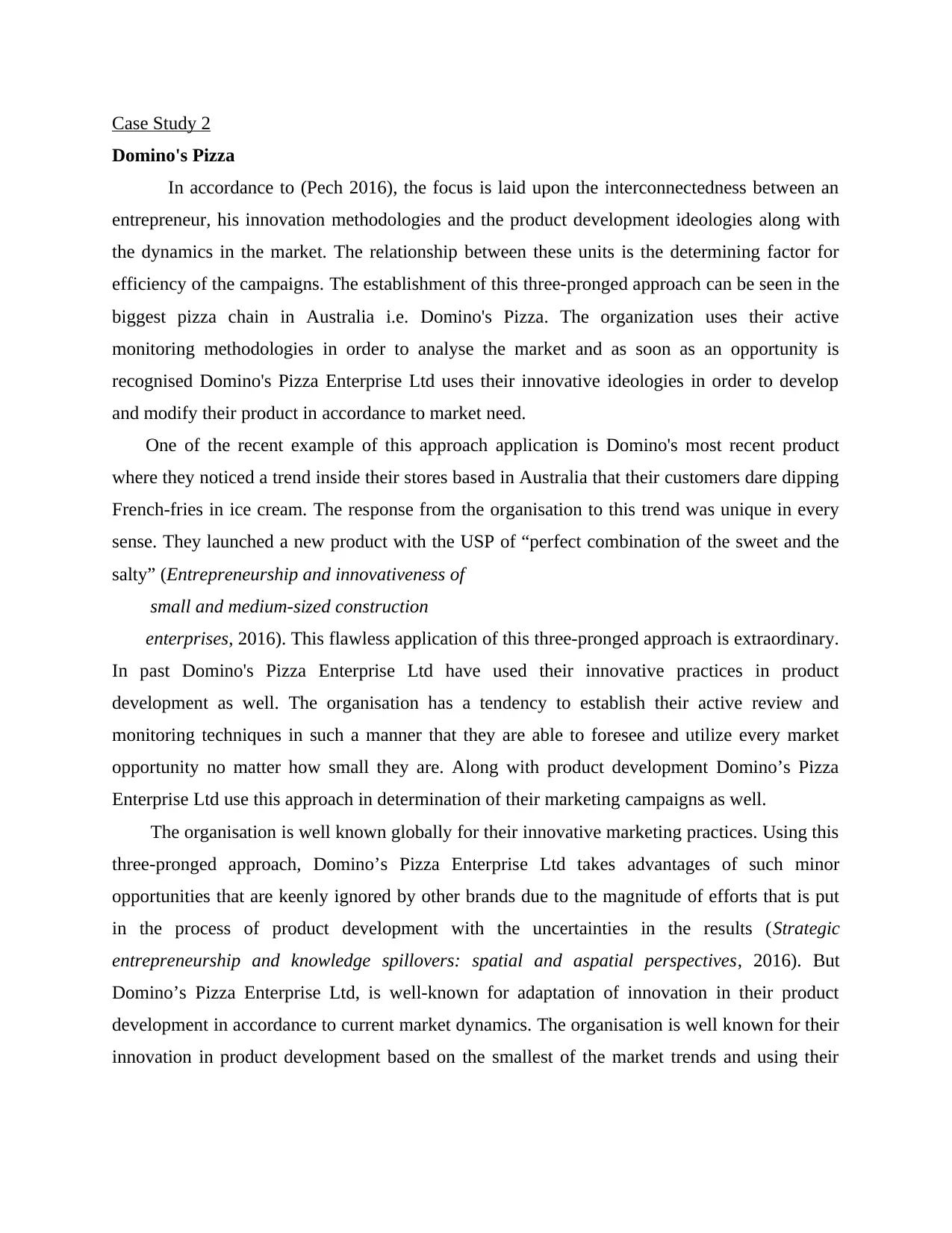
Case Study 2
Domino's Pizza
In accordance to (Pech 2016), the focus is laid upon the interconnectedness between an
entrepreneur, his innovation methodologies and the product development ideologies along with
the dynamics in the market. The relationship between these units is the determining factor for
efficiency of the campaigns. The establishment of this three-pronged approach can be seen in the
biggest pizza chain in Australia i.e. Domino's Pizza. The organization uses their active
monitoring methodologies in order to analyse the market and as soon as an opportunity is
recognised Domino's Pizza Enterprise Ltd uses their innovative ideologies in order to develop
and modify their product in accordance to market need.
One of the recent example of this approach application is Domino's most recent product
where they noticed a trend inside their stores based in Australia that their customers dare dipping
French-fries in ice cream. The response from the organisation to this trend was unique in every
sense. They launched a new product with the USP of “perfect combination of the sweet and the
salty” (Entrepreneurship and innovativeness of
small and medium-sized construction
enterprises, 2016). This flawless application of this three-pronged approach is extraordinary.
In past Domino's Pizza Enterprise Ltd have used their innovative practices in product
development as well. The organisation has a tendency to establish their active review and
monitoring techniques in such a manner that they are able to foresee and utilize every market
opportunity no matter how small they are. Along with product development Domino’s Pizza
Enterprise Ltd use this approach in determination of their marketing campaigns as well.
The organisation is well known globally for their innovative marketing practices. Using this
three-pronged approach, Domino’s Pizza Enterprise Ltd takes advantages of such minor
opportunities that are keenly ignored by other brands due to the magnitude of efforts that is put
in the process of product development with the uncertainties in the results (Strategic
entrepreneurship and knowledge spillovers: spatial and aspatial perspectives, 2016). But
Domino’s Pizza Enterprise Ltd, is well-known for adaptation of innovation in their product
development in accordance to current market dynamics. The organisation is well known for their
innovation in product development based on the smallest of the market trends and using their
Domino's Pizza
In accordance to (Pech 2016), the focus is laid upon the interconnectedness between an
entrepreneur, his innovation methodologies and the product development ideologies along with
the dynamics in the market. The relationship between these units is the determining factor for
efficiency of the campaigns. The establishment of this three-pronged approach can be seen in the
biggest pizza chain in Australia i.e. Domino's Pizza. The organization uses their active
monitoring methodologies in order to analyse the market and as soon as an opportunity is
recognised Domino's Pizza Enterprise Ltd uses their innovative ideologies in order to develop
and modify their product in accordance to market need.
One of the recent example of this approach application is Domino's most recent product
where they noticed a trend inside their stores based in Australia that their customers dare dipping
French-fries in ice cream. The response from the organisation to this trend was unique in every
sense. They launched a new product with the USP of “perfect combination of the sweet and the
salty” (Entrepreneurship and innovativeness of
small and medium-sized construction
enterprises, 2016). This flawless application of this three-pronged approach is extraordinary.
In past Domino's Pizza Enterprise Ltd have used their innovative practices in product
development as well. The organisation has a tendency to establish their active review and
monitoring techniques in such a manner that they are able to foresee and utilize every market
opportunity no matter how small they are. Along with product development Domino’s Pizza
Enterprise Ltd use this approach in determination of their marketing campaigns as well.
The organisation is well known globally for their innovative marketing practices. Using this
three-pronged approach, Domino’s Pizza Enterprise Ltd takes advantages of such minor
opportunities that are keenly ignored by other brands due to the magnitude of efforts that is put
in the process of product development with the uncertainties in the results (Strategic
entrepreneurship and knowledge spillovers: spatial and aspatial perspectives, 2016). But
Domino’s Pizza Enterprise Ltd, is well-known for adaptation of innovation in their product
development in accordance to current market dynamics. The organisation is well known for their
innovation in product development based on the smallest of the market trends and using their
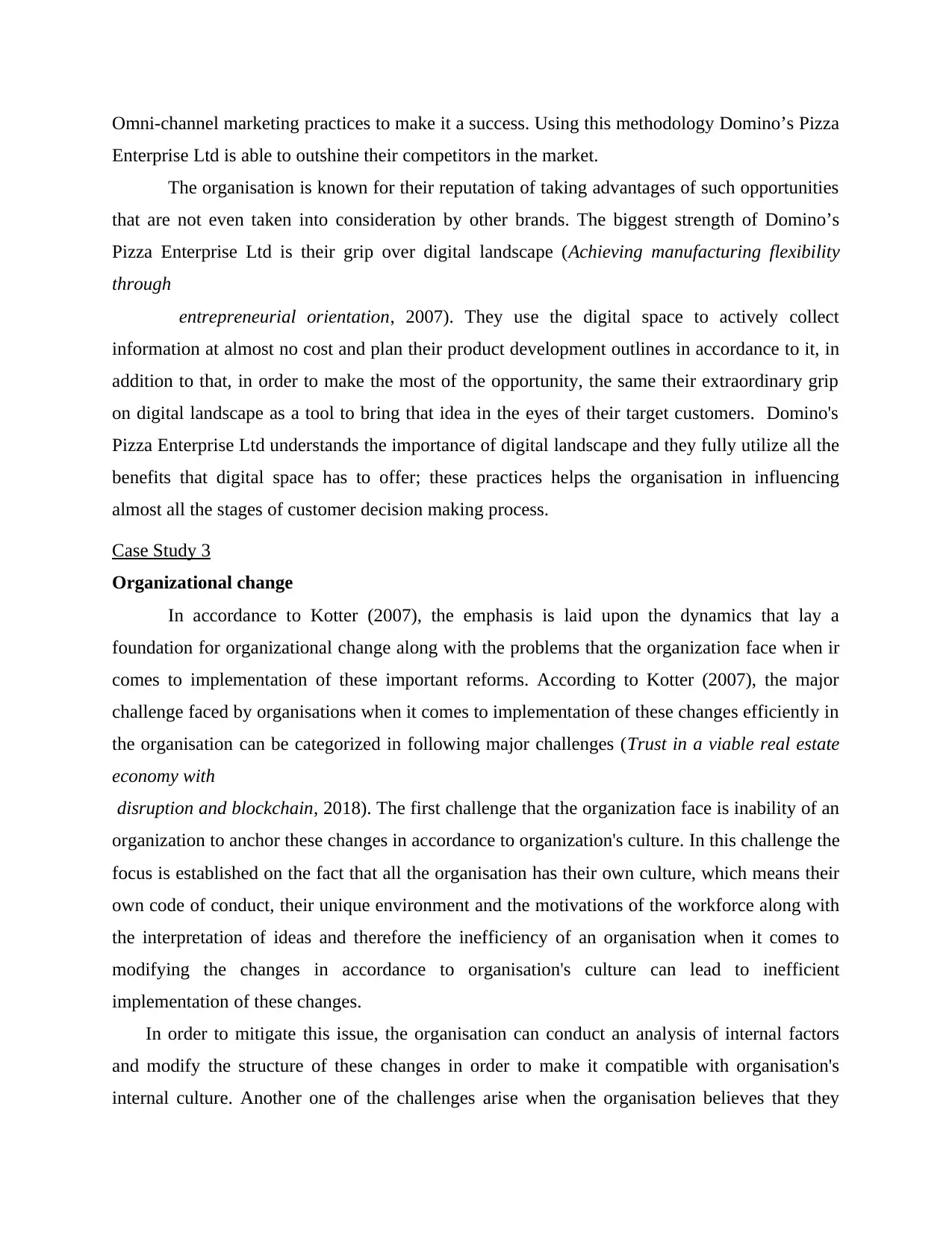
Omni-channel marketing practices to make it a success. Using this methodology Domino’s Pizza
Enterprise Ltd is able to outshine their competitors in the market.
The organisation is known for their reputation of taking advantages of such opportunities
that are not even taken into consideration by other brands. The biggest strength of Domino’s
Pizza Enterprise Ltd is their grip over digital landscape (Achieving manufacturing flexibility
through
entrepreneurial orientation, 2007). They use the digital space to actively collect
information at almost no cost and plan their product development outlines in accordance to it, in
addition to that, in order to make the most of the opportunity, the same their extraordinary grip
on digital landscape as a tool to bring that idea in the eyes of their target customers. Domino's
Pizza Enterprise Ltd understands the importance of digital landscape and they fully utilize all the
benefits that digital space has to offer; these practices helps the organisation in influencing
almost all the stages of customer decision making process.
Case Study 3
Organizational change
In accordance to Kotter (2007), the emphasis is laid upon the dynamics that lay a
foundation for organizational change along with the problems that the organization face when ir
comes to implementation of these important reforms. According to Kotter (2007), the major
challenge faced by organisations when it comes to implementation of these changes efficiently in
the organisation can be categorized in following major challenges (Trust in a viable real estate
economy with
disruption and blockchain, 2018). The first challenge that the organization face is inability of an
organization to anchor these changes in accordance to organization's culture. In this challenge the
focus is established on the fact that all the organisation has their own culture, which means their
own code of conduct, their unique environment and the motivations of the workforce along with
the interpretation of ideas and therefore the inefficiency of an organisation when it comes to
modifying the changes in accordance to organisation's culture can lead to inefficient
implementation of these changes.
In order to mitigate this issue, the organisation can conduct an analysis of internal factors
and modify the structure of these changes in order to make it compatible with organisation's
internal culture. Another one of the challenges arise when the organisation believes that they
Enterprise Ltd is able to outshine their competitors in the market.
The organisation is known for their reputation of taking advantages of such opportunities
that are not even taken into consideration by other brands. The biggest strength of Domino’s
Pizza Enterprise Ltd is their grip over digital landscape (Achieving manufacturing flexibility
through
entrepreneurial orientation, 2007). They use the digital space to actively collect
information at almost no cost and plan their product development outlines in accordance to it, in
addition to that, in order to make the most of the opportunity, the same their extraordinary grip
on digital landscape as a tool to bring that idea in the eyes of their target customers. Domino's
Pizza Enterprise Ltd understands the importance of digital landscape and they fully utilize all the
benefits that digital space has to offer; these practices helps the organisation in influencing
almost all the stages of customer decision making process.
Case Study 3
Organizational change
In accordance to Kotter (2007), the emphasis is laid upon the dynamics that lay a
foundation for organizational change along with the problems that the organization face when ir
comes to implementation of these important reforms. According to Kotter (2007), the major
challenge faced by organisations when it comes to implementation of these changes efficiently in
the organisation can be categorized in following major challenges (Trust in a viable real estate
economy with
disruption and blockchain, 2018). The first challenge that the organization face is inability of an
organization to anchor these changes in accordance to organization's culture. In this challenge the
focus is established on the fact that all the organisation has their own culture, which means their
own code of conduct, their unique environment and the motivations of the workforce along with
the interpretation of ideas and therefore the inefficiency of an organisation when it comes to
modifying the changes in accordance to organisation's culture can lead to inefficient
implementation of these changes.
In order to mitigate this issue, the organisation can conduct an analysis of internal factors
and modify the structure of these changes in order to make it compatible with organisation's
internal culture. Another one of the challenges arise when the organisation believes that they
⊘ This is a preview!⊘
Do you want full access?
Subscribe today to unlock all pages.

Trusted by 1+ million students worldwide
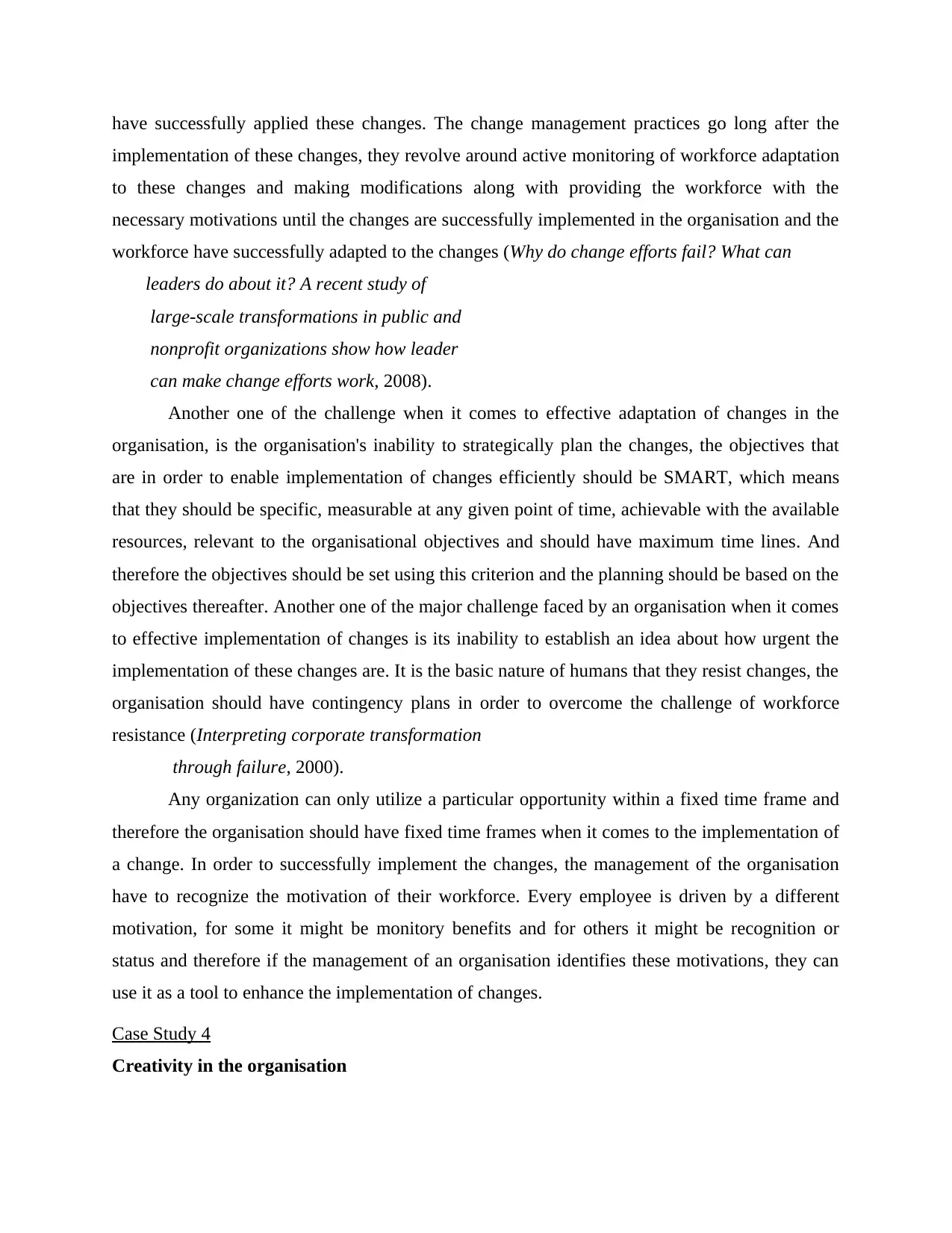
have successfully applied these changes. The change management practices go long after the
implementation of these changes, they revolve around active monitoring of workforce adaptation
to these changes and making modifications along with providing the workforce with the
necessary motivations until the changes are successfully implemented in the organisation and the
workforce have successfully adapted to the changes (Why do change efforts fail? What can
leaders do about it? A recent study of
large-scale transformations in public and
nonprofit organizations show how leader
can make change efforts work, 2008).
Another one of the challenge when it comes to effective adaptation of changes in the
organisation, is the organisation's inability to strategically plan the changes, the objectives that
are in order to enable implementation of changes efficiently should be SMART, which means
that they should be specific, measurable at any given point of time, achievable with the available
resources, relevant to the organisational objectives and should have maximum time lines. And
therefore the objectives should be set using this criterion and the planning should be based on the
objectives thereafter. Another one of the major challenge faced by an organisation when it comes
to effective implementation of changes is its inability to establish an idea about how urgent the
implementation of these changes are. It is the basic nature of humans that they resist changes, the
organisation should have contingency plans in order to overcome the challenge of workforce
resistance (Interpreting corporate transformation
through failure, 2000).
Any organization can only utilize a particular opportunity within a fixed time frame and
therefore the organisation should have fixed time frames when it comes to the implementation of
a change. In order to successfully implement the changes, the management of the organisation
have to recognize the motivation of their workforce. Every employee is driven by a different
motivation, for some it might be monitory benefits and for others it might be recognition or
status and therefore if the management of an organisation identifies these motivations, they can
use it as a tool to enhance the implementation of changes.
Case Study 4
Creativity in the organisation
implementation of these changes, they revolve around active monitoring of workforce adaptation
to these changes and making modifications along with providing the workforce with the
necessary motivations until the changes are successfully implemented in the organisation and the
workforce have successfully adapted to the changes (Why do change efforts fail? What can
leaders do about it? A recent study of
large-scale transformations in public and
nonprofit organizations show how leader
can make change efforts work, 2008).
Another one of the challenge when it comes to effective adaptation of changes in the
organisation, is the organisation's inability to strategically plan the changes, the objectives that
are in order to enable implementation of changes efficiently should be SMART, which means
that they should be specific, measurable at any given point of time, achievable with the available
resources, relevant to the organisational objectives and should have maximum time lines. And
therefore the objectives should be set using this criterion and the planning should be based on the
objectives thereafter. Another one of the major challenge faced by an organisation when it comes
to effective implementation of changes is its inability to establish an idea about how urgent the
implementation of these changes are. It is the basic nature of humans that they resist changes, the
organisation should have contingency plans in order to overcome the challenge of workforce
resistance (Interpreting corporate transformation
through failure, 2000).
Any organization can only utilize a particular opportunity within a fixed time frame and
therefore the organisation should have fixed time frames when it comes to the implementation of
a change. In order to successfully implement the changes, the management of the organisation
have to recognize the motivation of their workforce. Every employee is driven by a different
motivation, for some it might be monitory benefits and for others it might be recognition or
status and therefore if the management of an organisation identifies these motivations, they can
use it as a tool to enhance the implementation of changes.
Case Study 4
Creativity in the organisation
Paraphrase This Document
Need a fresh take? Get an instant paraphrase of this document with our AI Paraphraser
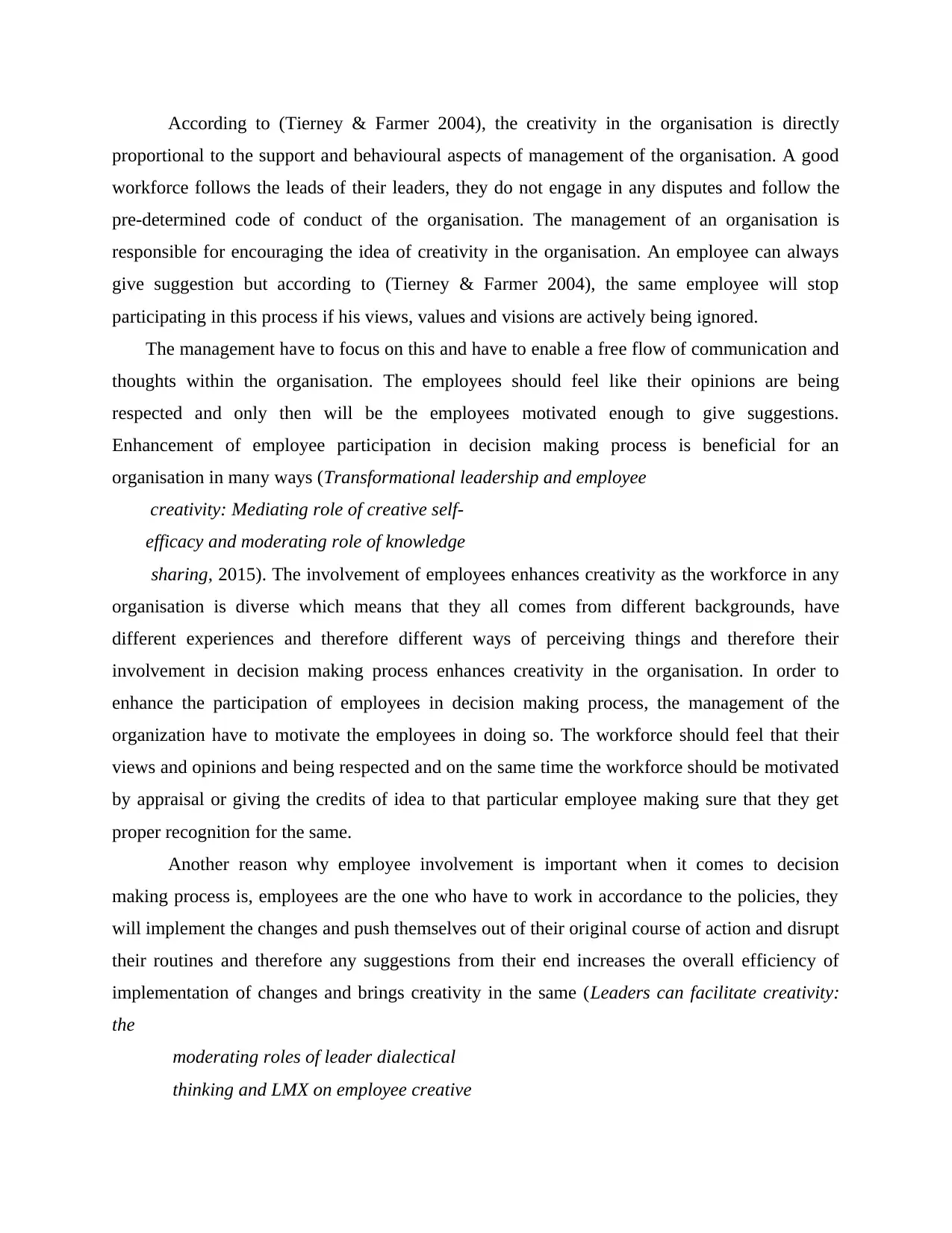
According to (Tierney & Farmer 2004), the creativity in the organisation is directly
proportional to the support and behavioural aspects of management of the organisation. A good
workforce follows the leads of their leaders, they do not engage in any disputes and follow the
pre-determined code of conduct of the organisation. The management of an organisation is
responsible for encouraging the idea of creativity in the organisation. An employee can always
give suggestion but according to (Tierney & Farmer 2004), the same employee will stop
participating in this process if his views, values and visions are actively being ignored.
The management have to focus on this and have to enable a free flow of communication and
thoughts within the organisation. The employees should feel like their opinions are being
respected and only then will be the employees motivated enough to give suggestions.
Enhancement of employee participation in decision making process is beneficial for an
organisation in many ways (Transformational leadership and employee
creativity: Mediating role of creative self-
efficacy and moderating role of knowledge
sharing, 2015). The involvement of employees enhances creativity as the workforce in any
organisation is diverse which means that they all comes from different backgrounds, have
different experiences and therefore different ways of perceiving things and therefore their
involvement in decision making process enhances creativity in the organisation. In order to
enhance the participation of employees in decision making process, the management of the
organization have to motivate the employees in doing so. The workforce should feel that their
views and opinions and being respected and on the same time the workforce should be motivated
by appraisal or giving the credits of idea to that particular employee making sure that they get
proper recognition for the same.
Another reason why employee involvement is important when it comes to decision
making process is, employees are the one who have to work in accordance to the policies, they
will implement the changes and push themselves out of their original course of action and disrupt
their routines and therefore any suggestions from their end increases the overall efficiency of
implementation of changes and brings creativity in the same (Leaders can facilitate creativity:
the
moderating roles of leader dialectical
thinking and LMX on employee creative
proportional to the support and behavioural aspects of management of the organisation. A good
workforce follows the leads of their leaders, they do not engage in any disputes and follow the
pre-determined code of conduct of the organisation. The management of an organisation is
responsible for encouraging the idea of creativity in the organisation. An employee can always
give suggestion but according to (Tierney & Farmer 2004), the same employee will stop
participating in this process if his views, values and visions are actively being ignored.
The management have to focus on this and have to enable a free flow of communication and
thoughts within the organisation. The employees should feel like their opinions are being
respected and only then will be the employees motivated enough to give suggestions.
Enhancement of employee participation in decision making process is beneficial for an
organisation in many ways (Transformational leadership and employee
creativity: Mediating role of creative self-
efficacy and moderating role of knowledge
sharing, 2015). The involvement of employees enhances creativity as the workforce in any
organisation is diverse which means that they all comes from different backgrounds, have
different experiences and therefore different ways of perceiving things and therefore their
involvement in decision making process enhances creativity in the organisation. In order to
enhance the participation of employees in decision making process, the management of the
organization have to motivate the employees in doing so. The workforce should feel that their
views and opinions and being respected and on the same time the workforce should be motivated
by appraisal or giving the credits of idea to that particular employee making sure that they get
proper recognition for the same.
Another reason why employee involvement is important when it comes to decision
making process is, employees are the one who have to work in accordance to the policies, they
will implement the changes and push themselves out of their original course of action and disrupt
their routines and therefore any suggestions from their end increases the overall efficiency of
implementation of changes and brings creativity in the same (Leaders can facilitate creativity:
the
moderating roles of leader dialectical
thinking and LMX on employee creative
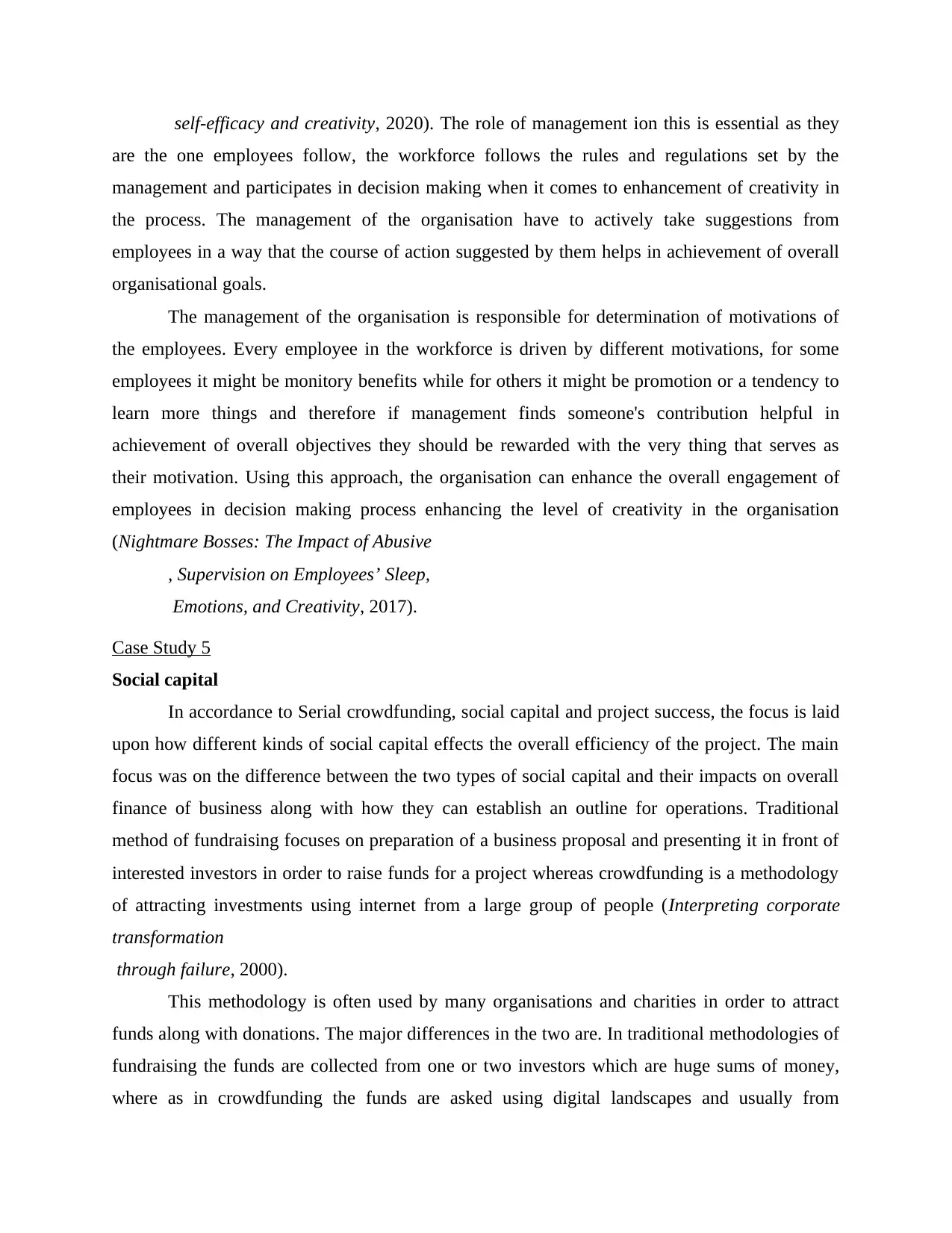
self-efficacy and creativity, 2020). The role of management ion this is essential as they
are the one employees follow, the workforce follows the rules and regulations set by the
management and participates in decision making when it comes to enhancement of creativity in
the process. The management of the organisation have to actively take suggestions from
employees in a way that the course of action suggested by them helps in achievement of overall
organisational goals.
The management of the organisation is responsible for determination of motivations of
the employees. Every employee in the workforce is driven by different motivations, for some
employees it might be monitory benefits while for others it might be promotion or a tendency to
learn more things and therefore if management finds someone's contribution helpful in
achievement of overall objectives they should be rewarded with the very thing that serves as
their motivation. Using this approach, the organisation can enhance the overall engagement of
employees in decision making process enhancing the level of creativity in the organisation
(Nightmare Bosses: The Impact of Abusive
, Supervision on Employees’ Sleep,
Emotions, and Creativity, 2017).
Case Study 5
Social capital
In accordance to Serial crowdfunding, social capital and project success, the focus is laid
upon how different kinds of social capital effects the overall efficiency of the project. The main
focus was on the difference between the two types of social capital and their impacts on overall
finance of business along with how they can establish an outline for operations. Traditional
method of fundraising focuses on preparation of a business proposal and presenting it in front of
interested investors in order to raise funds for a project whereas crowdfunding is a methodology
of attracting investments using internet from a large group of people (Interpreting corporate
transformation
through failure, 2000).
This methodology is often used by many organisations and charities in order to attract
funds along with donations. The major differences in the two are. In traditional methodologies of
fundraising the funds are collected from one or two investors which are huge sums of money,
where as in crowdfunding the funds are asked using digital landscapes and usually from
are the one employees follow, the workforce follows the rules and regulations set by the
management and participates in decision making when it comes to enhancement of creativity in
the process. The management of the organisation have to actively take suggestions from
employees in a way that the course of action suggested by them helps in achievement of overall
organisational goals.
The management of the organisation is responsible for determination of motivations of
the employees. Every employee in the workforce is driven by different motivations, for some
employees it might be monitory benefits while for others it might be promotion or a tendency to
learn more things and therefore if management finds someone's contribution helpful in
achievement of overall objectives they should be rewarded with the very thing that serves as
their motivation. Using this approach, the organisation can enhance the overall engagement of
employees in decision making process enhancing the level of creativity in the organisation
(Nightmare Bosses: The Impact of Abusive
, Supervision on Employees’ Sleep,
Emotions, and Creativity, 2017).
Case Study 5
Social capital
In accordance to Serial crowdfunding, social capital and project success, the focus is laid
upon how different kinds of social capital effects the overall efficiency of the project. The main
focus was on the difference between the two types of social capital and their impacts on overall
finance of business along with how they can establish an outline for operations. Traditional
method of fundraising focuses on preparation of a business proposal and presenting it in front of
interested investors in order to raise funds for a project whereas crowdfunding is a methodology
of attracting investments using internet from a large group of people (Interpreting corporate
transformation
through failure, 2000).
This methodology is often used by many organisations and charities in order to attract
funds along with donations. The major differences in the two are. In traditional methodologies of
fundraising the funds are collected from one or two investors which are huge sums of money,
where as in crowdfunding the funds are asked using digital landscapes and usually from
⊘ This is a preview!⊘
Do you want full access?
Subscribe today to unlock all pages.

Trusted by 1+ million students worldwide
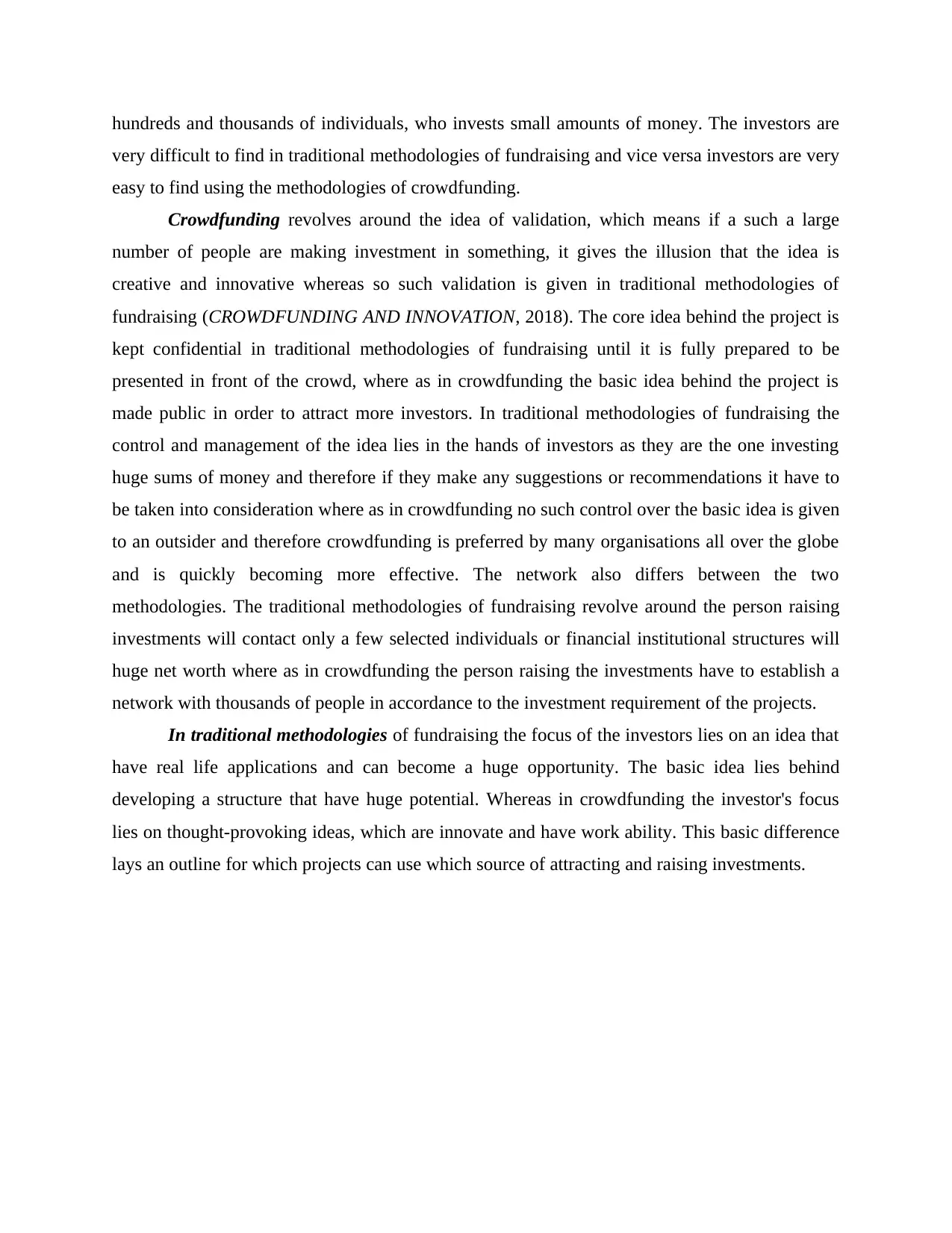
hundreds and thousands of individuals, who invests small amounts of money. The investors are
very difficult to find in traditional methodologies of fundraising and vice versa investors are very
easy to find using the methodologies of crowdfunding.
Crowdfunding revolves around the idea of validation, which means if a such a large
number of people are making investment in something, it gives the illusion that the idea is
creative and innovative whereas so such validation is given in traditional methodologies of
fundraising (CROWDFUNDING AND INNOVATION, 2018). The core idea behind the project is
kept confidential in traditional methodologies of fundraising until it is fully prepared to be
presented in front of the crowd, where as in crowdfunding the basic idea behind the project is
made public in order to attract more investors. In traditional methodologies of fundraising the
control and management of the idea lies in the hands of investors as they are the one investing
huge sums of money and therefore if they make any suggestions or recommendations it have to
be taken into consideration where as in crowdfunding no such control over the basic idea is given
to an outsider and therefore crowdfunding is preferred by many organisations all over the globe
and is quickly becoming more effective. The network also differs between the two
methodologies. The traditional methodologies of fundraising revolve around the person raising
investments will contact only a few selected individuals or financial institutional structures will
huge net worth where as in crowdfunding the person raising the investments have to establish a
network with thousands of people in accordance to the investment requirement of the projects.
In traditional methodologies of fundraising the focus of the investors lies on an idea that
have real life applications and can become a huge opportunity. The basic idea lies behind
developing a structure that have huge potential. Whereas in crowdfunding the investor's focus
lies on thought-provoking ideas, which are innovate and have work ability. This basic difference
lays an outline for which projects can use which source of attracting and raising investments.
very difficult to find in traditional methodologies of fundraising and vice versa investors are very
easy to find using the methodologies of crowdfunding.
Crowdfunding revolves around the idea of validation, which means if a such a large
number of people are making investment in something, it gives the illusion that the idea is
creative and innovative whereas so such validation is given in traditional methodologies of
fundraising (CROWDFUNDING AND INNOVATION, 2018). The core idea behind the project is
kept confidential in traditional methodologies of fundraising until it is fully prepared to be
presented in front of the crowd, where as in crowdfunding the basic idea behind the project is
made public in order to attract more investors. In traditional methodologies of fundraising the
control and management of the idea lies in the hands of investors as they are the one investing
huge sums of money and therefore if they make any suggestions or recommendations it have to
be taken into consideration where as in crowdfunding no such control over the basic idea is given
to an outsider and therefore crowdfunding is preferred by many organisations all over the globe
and is quickly becoming more effective. The network also differs between the two
methodologies. The traditional methodologies of fundraising revolve around the person raising
investments will contact only a few selected individuals or financial institutional structures will
huge net worth where as in crowdfunding the person raising the investments have to establish a
network with thousands of people in accordance to the investment requirement of the projects.
In traditional methodologies of fundraising the focus of the investors lies on an idea that
have real life applications and can become a huge opportunity. The basic idea lies behind
developing a structure that have huge potential. Whereas in crowdfunding the investor's focus
lies on thought-provoking ideas, which are innovate and have work ability. This basic difference
lays an outline for which projects can use which source of attracting and raising investments.
Paraphrase This Document
Need a fresh take? Get an instant paraphrase of this document with our AI Paraphraser
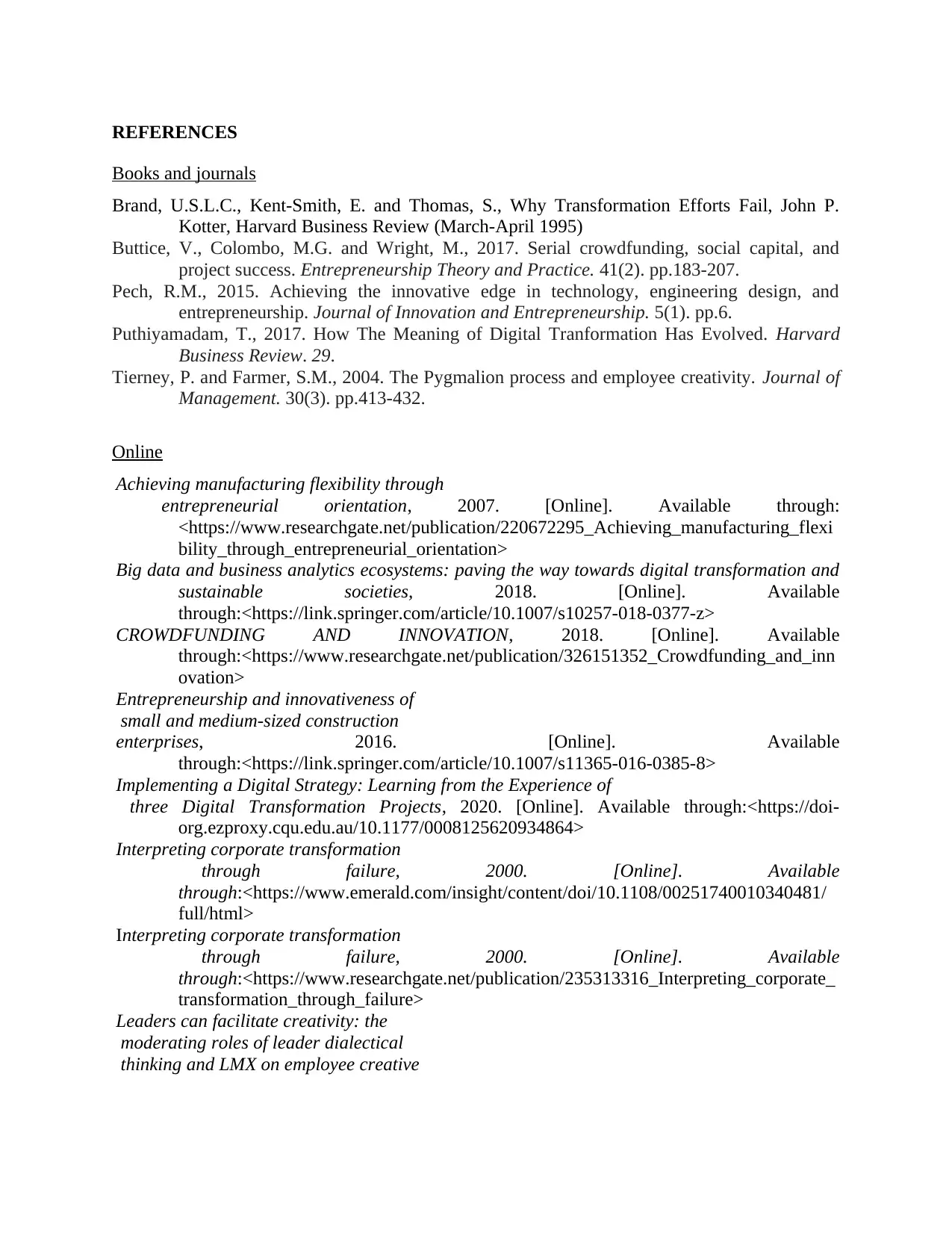
REFERENCES
Books and journals
Brand, U.S.L.C., Kent-Smith, E. and Thomas, S., Why Transformation Efforts Fail, John P.
Kotter, Harvard Business Review (March-April 1995)
Buttice, V., Colombo, M.G. and Wright, M., 2017. Serial crowdfunding, social capital, and
project success. Entrepreneurship Theory and Practice. 41(2). pp.183-207.
Pech, R.M., 2015. Achieving the innovative edge in technology, engineering design, and
entrepreneurship. Journal of Innovation and Entrepreneurship. 5(1). pp.6.
Puthiyamadam, T., 2017. How The Meaning of Digital Tranformation Has Evolved. Harvard
Business Review. 29.
Tierney, P. and Farmer, S.M., 2004. The Pygmalion process and employee creativity. Journal of
Management. 30(3). pp.413-432.
Online
Achieving manufacturing flexibility through
entrepreneurial orientation, 2007. [Online]. Available through:
<https://www.researchgate.net/publication/220672295_Achieving_manufacturing_flexi
bility_through_entrepreneurial_orientation>
Big data and business analytics ecosystems: paving the way towards digital transformation and
sustainable societies, 2018. [Online]. Available
through:<https://link.springer.com/article/10.1007/s10257-018-0377-z>
CROWDFUNDING AND INNOVATION, 2018. [Online]. Available
through:<https://www.researchgate.net/publication/326151352_Crowdfunding_and_inn
ovation>
Entrepreneurship and innovativeness of
small and medium-sized construction
enterprises, 2016. [Online]. Available
through:<https://link.springer.com/article/10.1007/s11365-016-0385-8>
Implementing a Digital Strategy: Learning from the Experience of
three Digital Transformation Projects, 2020. [Online]. Available through:<https://doi-
org.ezproxy.cqu.edu.au/10.1177/0008125620934864>
Interpreting corporate transformation
through failure, 2000. [Online]. Available
through:<https://www.emerald.com/insight/content/doi/10.1108/00251740010340481/
full/html>
Interpreting corporate transformation
through failure, 2000. [Online]. Available
through:<https://www.researchgate.net/publication/235313316_Interpreting_corporate_
transformation_through_failure>
Leaders can facilitate creativity: the
moderating roles of leader dialectical
thinking and LMX on employee creative
Books and journals
Brand, U.S.L.C., Kent-Smith, E. and Thomas, S., Why Transformation Efforts Fail, John P.
Kotter, Harvard Business Review (March-April 1995)
Buttice, V., Colombo, M.G. and Wright, M., 2017. Serial crowdfunding, social capital, and
project success. Entrepreneurship Theory and Practice. 41(2). pp.183-207.
Pech, R.M., 2015. Achieving the innovative edge in technology, engineering design, and
entrepreneurship. Journal of Innovation and Entrepreneurship. 5(1). pp.6.
Puthiyamadam, T., 2017. How The Meaning of Digital Tranformation Has Evolved. Harvard
Business Review. 29.
Tierney, P. and Farmer, S.M., 2004. The Pygmalion process and employee creativity. Journal of
Management. 30(3). pp.413-432.
Online
Achieving manufacturing flexibility through
entrepreneurial orientation, 2007. [Online]. Available through:
<https://www.researchgate.net/publication/220672295_Achieving_manufacturing_flexi
bility_through_entrepreneurial_orientation>
Big data and business analytics ecosystems: paving the way towards digital transformation and
sustainable societies, 2018. [Online]. Available
through:<https://link.springer.com/article/10.1007/s10257-018-0377-z>
CROWDFUNDING AND INNOVATION, 2018. [Online]. Available
through:<https://www.researchgate.net/publication/326151352_Crowdfunding_and_inn
ovation>
Entrepreneurship and innovativeness of
small and medium-sized construction
enterprises, 2016. [Online]. Available
through:<https://link.springer.com/article/10.1007/s11365-016-0385-8>
Implementing a Digital Strategy: Learning from the Experience of
three Digital Transformation Projects, 2020. [Online]. Available through:<https://doi-
org.ezproxy.cqu.edu.au/10.1177/0008125620934864>
Interpreting corporate transformation
through failure, 2000. [Online]. Available
through:<https://www.emerald.com/insight/content/doi/10.1108/00251740010340481/
full/html>
Interpreting corporate transformation
through failure, 2000. [Online]. Available
through:<https://www.researchgate.net/publication/235313316_Interpreting_corporate_
transformation_through_failure>
Leaders can facilitate creativity: the
moderating roles of leader dialectical
thinking and LMX on employee creative
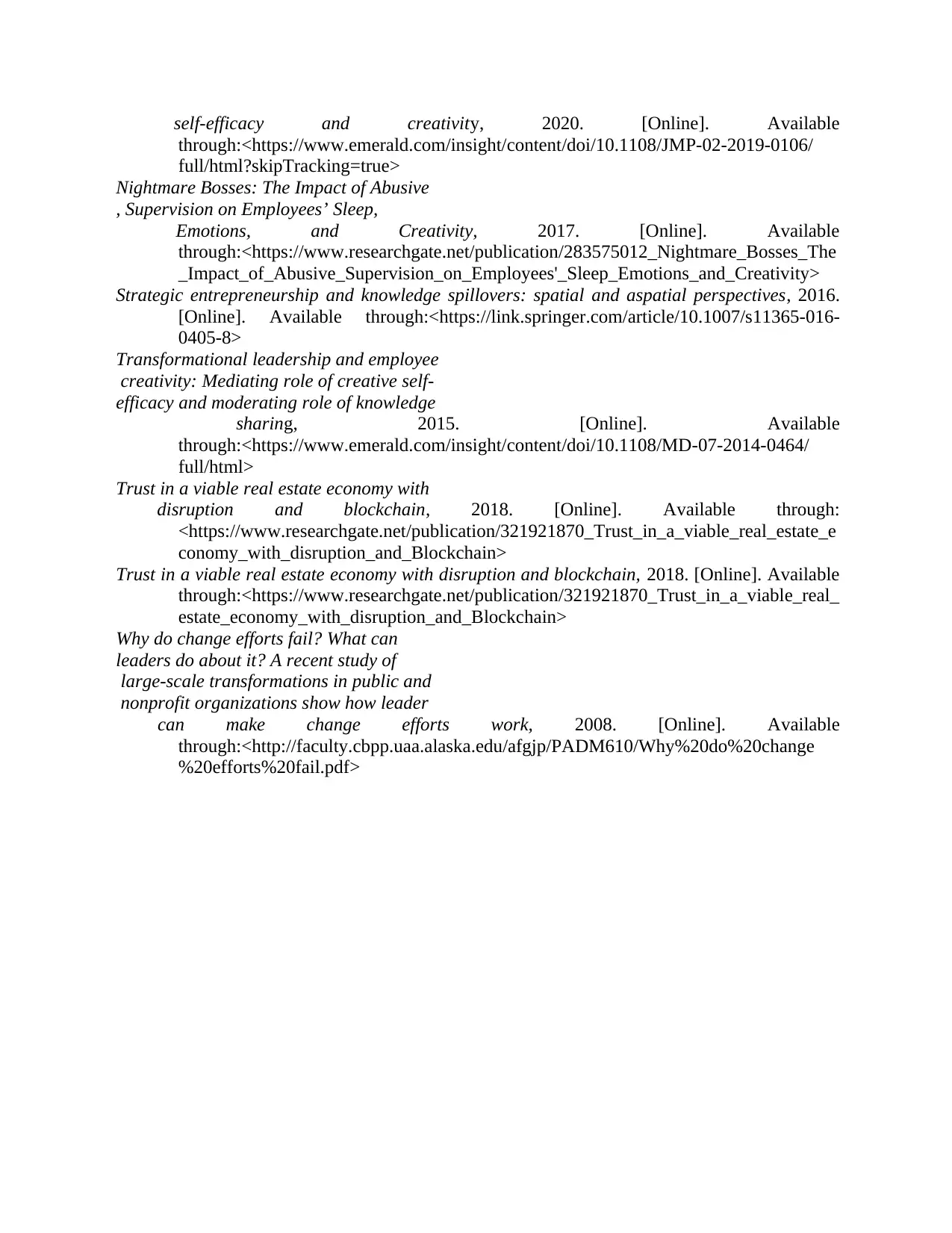
self-efficacy and creativity, 2020. [Online]. Available
through:<https://www.emerald.com/insight/content/doi/10.1108/JMP-02-2019-0106/
full/html?skipTracking=true>
Nightmare Bosses: The Impact of Abusive
, Supervision on Employees’ Sleep,
Emotions, and Creativity, 2017. [Online]. Available
through:<https://www.researchgate.net/publication/283575012_Nightmare_Bosses_The
_Impact_of_Abusive_Supervision_on_Employees'_Sleep_Emotions_and_Creativity>
Strategic entrepreneurship and knowledge spillovers: spatial and aspatial perspectives, 2016.
[Online]. Available through:<https://link.springer.com/article/10.1007/s11365-016-
0405-8>
Transformational leadership and employee
creativity: Mediating role of creative self-
efficacy and moderating role of knowledge
sharing, 2015. [Online]. Available
through:<https://www.emerald.com/insight/content/doi/10.1108/MD-07-2014-0464/
full/html>
Trust in a viable real estate economy with
disruption and blockchain, 2018. [Online]. Available through:
<https://www.researchgate.net/publication/321921870_Trust_in_a_viable_real_estate_e
conomy_with_disruption_and_Blockchain>
Trust in a viable real estate economy with disruption and blockchain, 2018. [Online]. Available
through:<https://www.researchgate.net/publication/321921870_Trust_in_a_viable_real_
estate_economy_with_disruption_and_Blockchain>
Why do change efforts fail? What can
leaders do about it? A recent study of
large-scale transformations in public and
nonprofit organizations show how leader
can make change efforts work, 2008. [Online]. Available
through:<http://faculty.cbpp.uaa.alaska.edu/afgjp/PADM610/Why%20do%20change
%20efforts%20fail.pdf>
through:<https://www.emerald.com/insight/content/doi/10.1108/JMP-02-2019-0106/
full/html?skipTracking=true>
Nightmare Bosses: The Impact of Abusive
, Supervision on Employees’ Sleep,
Emotions, and Creativity, 2017. [Online]. Available
through:<https://www.researchgate.net/publication/283575012_Nightmare_Bosses_The
_Impact_of_Abusive_Supervision_on_Employees'_Sleep_Emotions_and_Creativity>
Strategic entrepreneurship and knowledge spillovers: spatial and aspatial perspectives, 2016.
[Online]. Available through:<https://link.springer.com/article/10.1007/s11365-016-
0405-8>
Transformational leadership and employee
creativity: Mediating role of creative self-
efficacy and moderating role of knowledge
sharing, 2015. [Online]. Available
through:<https://www.emerald.com/insight/content/doi/10.1108/MD-07-2014-0464/
full/html>
Trust in a viable real estate economy with
disruption and blockchain, 2018. [Online]. Available through:
<https://www.researchgate.net/publication/321921870_Trust_in_a_viable_real_estate_e
conomy_with_disruption_and_Blockchain>
Trust in a viable real estate economy with disruption and blockchain, 2018. [Online]. Available
through:<https://www.researchgate.net/publication/321921870_Trust_in_a_viable_real_
estate_economy_with_disruption_and_Blockchain>
Why do change efforts fail? What can
leaders do about it? A recent study of
large-scale transformations in public and
nonprofit organizations show how leader
can make change efforts work, 2008. [Online]. Available
through:<http://faculty.cbpp.uaa.alaska.edu/afgjp/PADM610/Why%20do%20change
%20efforts%20fail.pdf>
⊘ This is a preview!⊘
Do you want full access?
Subscribe today to unlock all pages.

Trusted by 1+ million students worldwide
1 out of 12
Related Documents
Your All-in-One AI-Powered Toolkit for Academic Success.
+13062052269
info@desklib.com
Available 24*7 on WhatsApp / Email
![[object Object]](/_next/static/media/star-bottom.7253800d.svg)
Unlock your academic potential
Copyright © 2020–2025 A2Z Services. All Rights Reserved. Developed and managed by ZUCOL.





